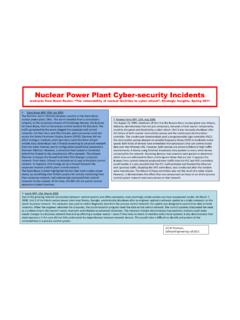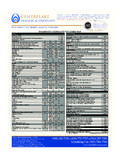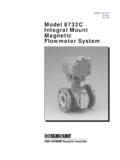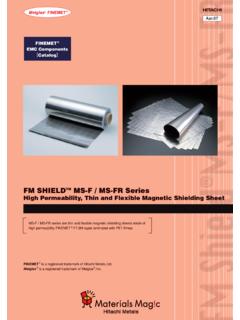Transcription of Nazi nuclear research - Safety In Engineering
1 1 Jim nuclear research : Why didn t Hitler get the Bomb? nazi nuclear German project and a brief comparison with the Manhattan and V-weapons project technical achievements and and organisational , ethics, competence and : The lunatic fringesJim Thomson The German project and a brief comparison with the Manhattan and V-weapons projects3 Jim Thomson of fissionGermany 1938/39 First German government interest April 1939 First sub-critical pile, Autumn 1940 Einstein letter to Roosevelt August 1939 Frisch-Peierlsmemorandum March 1940 February 1942: Presentation to senior Government officials. Despite suggesting bombs the size of pineapples , the nuclear project is judged not to help war effort on the necessary timescale and is therefore downgraded in importance.
2 Responsibility moved from Army Ordnance to Reich research CouncilMay/June 1942:L-IV pile shows neutron multiplication, then destroyed inhydrogen explosionMarch 1945: B-VIII pile at Haigerlochfails to go criticalDec 1942: Chicago pile criticalOngoing efforts at enrichmentMay-Dec 1945: Ten members of team interned at Farm Hall, Cambridge1943: Vemorkheavy water plant destroyed4 April 1943: Los Alamos Primer lecture notes give complete overview of bomb project1944/1945: ALSOS mission to capture German researchers , equipment and dataJuly/Aug 1945:Trinity, Little Boy and Fat Man. The Smyth Report outlines the Manhattan project1947:Heisenberg publishes his account in Nature1968: The Virus House -David Irving1956: Brighter Than a Thousand Suns Robert Jungk1947:ALSOS Samuel Goudsmit(republished 1996)Arnold Kramish1985 The GriffinMark Walker1989 German National Socialism and the Quest for nuclear Power 1939 1949UK Government1992 Farm Hall transcripts declassifiedDavid Cassidy1992 Uncertainty: The Life and Science of Werner HeisenbergThomas Powers1993 Heisenberg s WarMark Walker1995 nazi Science: Myth, Truth, and the German Atomic BombPaul Lawrence Rose1998 Heisenberg and the nazi Atomic Bomb Project.
3 A Study in German CultureHans Bethe2000 The German Uranium Project , Article in Physics TodayJeremy Bernstein and David Cassidy2001 Hitler's Uranium Club: The Secret Recordings at Farm HallJim Thomson were the Allies so worried about the Germans?For example: Heisenberg: Nobel prize 1932 for quantum mechanics and the Uncertainty Principle . Refused offer to move to USA in summer 1939 (when he visited Goudsmitin USA). von Weizs cker: Physicist with extremely good political connections; pupil of Heisenberg. Hahn: Discoverer of fission 1938. Worked with Fritz Haber on poison gas during WW1. Discovered Protoactinium1921. Clusius: First person (1939) to separate the two naturally-occurring isotopes of chlorine Cl-35 and Thomson s letter to President Roosevelt,2 August 1939(drafted by Leo Szilard) I understand that Germany has actually stopped the sale of uranium from the Czechoslovakian mines which she has taken over.
4 That she should have taken such early action might perhaps be understood on the ground that the son of the German Under-Secretary of State, von Weizsacker, is attached to the Kaiser Wilhelm Institute in Berlin, where some of the American work on uranium is now being repeated. Jim Thomson from the Frisch-Peierlsmemorandum, Birmingham UK, March 1940 (written before anyone really knew the scale of the effort needed) ..it is quite conceivable that Germany is, in fact, developing this weapon. Whether this is the case is difficult to find out, since the plant for the separation of isotopes need not be of such a size as to attract attention. Information that could be helpful in this respect would be data about the exploitation of the uranium mines under German control (mainly in Czechoslovakia) and about any recent German purchases of uranium abroad.
5 It is likely that the plant would be controlled by Dr. K. Clusius(Professor of Physical Chemistry in Munich University), the inventor of the best method for separating isotopes, and therefore information as to his whereabouts and status might also give an important Since the separation of the necessary amount of uranium is, in the most favourable circumstances, a matter of several months, it would obviously be too late to start production when such a bomb is known to be in the hands of Germany, and the matter seems, therefore, very For the separation of the uranium 235, the method of thermal diffusion, developed by Clusiusand others, seems to be the only one which can cope with the large amounts required.
6 7 Jim Thomson view from Soviet Russia in 1940 GeorgiFlerov(Soviet physicist who worked on the Soviet weapons programme and who also discovered in 1940 the spontaneous fission of uranium): It seemed to us that if someone could make a nuclear bomb, it would be neither the Americans, English or French but Germans. The Germans had brilliant chemistry; they had technology for the production of metallic uranium; they were involved in experiments on the centrifugal separation of uranium isotopes. And, finally, the Germans possessed heavy water and reserves of uranium. Our first impression was that Germans were capable of making the thing. It was obvious what the consequences would be if they succeeded.
7 8 Jim Thomson key German scientists9 Walther Gerlach1889-1979 Werner Heisenberg1901-1976 Otto Hahn 1879-1968 Paul Harteck1902-1985 Carl-Friedrichvon Weizs cker1912-2007 Carl Wirtz1910-1994 Kurt Diebner1905-1964 Erich Bagge1912-1996 Walter Bothe1891-1957 Klaus Clusius1903-1963 Jim Thomson Bagge1912-1996 Developed a uranium enrichment device in 1944. nazi Party at Farm Hall Bothe1891-1957 Theoretical physicist. Nobel Prize 1954 for study of wave-particle duality. An important member of the German nuclear project, his measurements led to the conclusion that graphite was not a suitable moderator, probably due to boron contamination. Klaus Clusius 1903-1963In 1939 he achieved the separation of the natural chlorine isotopes.
8 During WW2, he worked on isotope separation and heavy waterproduction. Zurich University 1947 to Diebner1905-1964 Overall manager of the German nuclear project. After WW2, worked with Baggeon marine applications of nuclear power. nazi at Farm Hall Geiger1882-1945 Developed Geiger counter. Geiger-Marsdenexperiment (1909) discovered atomic nucleus. Enigmatic, he expressed no views about Gerlach1889-1979In 1921 he discovered spin quantisation in a magnetic field (the Stern-Gerlacheffect). Head of Physics in the Reichforshungsrat(Reich research Council) 1944-1945. University of Munich at Farm Hall Hahn1879-1968 With LiseMeitner, discovered Protoactinium1921. Director of the Kaiser Wilhelm Institute for Chemistry 1928 to 1946.
9 With his student Fritz Strassman, and also LiseMeitner and Otto Frisch, he discovered fission in 1938. An opponent of Jewish persecution in nazi Germany, he did not contribute to the wartime nuclear research programme. Nobel Prize at Farm Hall Harteck1902-1985 Alerted the Herreswaffenamt(Army Weapons Office) in April 1939 about the possible military applications of nuclear research . Did work on uranium isotope separation and heavy water production. Developed a prototype centrifuge for isotope separation. Rensselaer Polytechnic Institute, New York, 1955 to 1968. Prisoner at Farm Hall Heisenberg1901-1976 Key founder of quantum mechanics. Nobel Prize 1932. Technical leader of the German wartime nuclear research programmes.
10 AfterWW2, he was involved in the first German nuclear reactor at Karlruhe. Director of the Kaiser Wilhelm Institute for Physics (KWIP) (later re-named the Max Planck Institute for Physics). Prisoner at Farm Hall Jordan1902-1980 Theoretical physicist, one of the founders of quantum mechanics. nazi Party Korsching1912-1998A colleague of Karl Wirtz, he worked on isotope separation during WW2. Prisoner at Farm Hall von Laue 1879-1960 Discovered diffraction of X-rays by crystals. Nobel Prize 1914. A strong anti- nazi , he took no part in the wartime nuclear research programme. A prisoner at Farm Hall 1945, this may have been to stop the Soviets capturing Wirtz 1910-1994 Scientist at KWIP who worked on reactor design.













